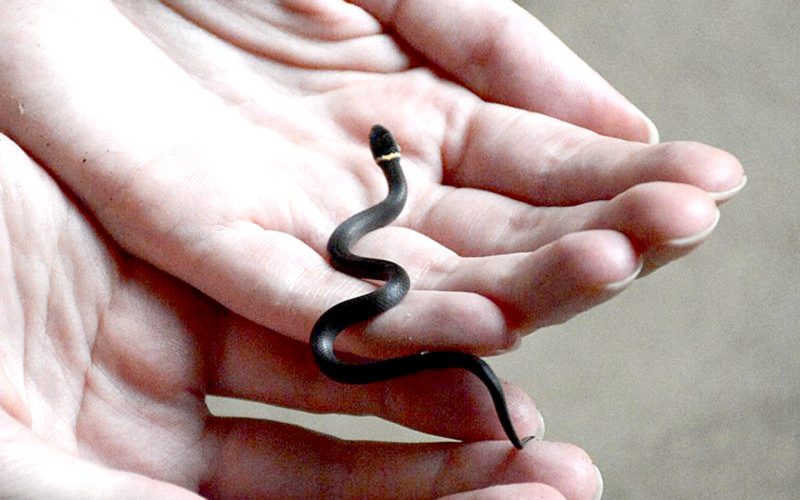
Photo by Ryan Bancroft
A juvenile ring-necked snake crawls along Amanda Bancroft’s hands on her porch near Fayetteville.
Northwest Arkansas is swimming in baby reptiles this time of year. Observing them can bring forth reactions typical of cute online videos of adorable animals, despite their distinctively reptilian features. Tiny lizards the color of the rainbow and small snakes that are safe to handle can be found even in urban residential neighborhoods, provided there is good habitat nearby.
A Ring-Necked Snake could make a great science project now that students are back to school. They’re easy to handle and are frequently kept as pets, but it’s nice to release them where you found them, in the wild where they can continue to take their place in the great circle of life. These snakes will trick you into thinking they’re aesthetically dull, with dark black or gray heads and bodies with simply an attractive yellow, orange or red collar around their necks. But gently flip one over to see its underside, and a sunset will squirm around in your hand. Their belly scales are often yellow fading into orange fading into red, even when they’re young. The adults are quite small, easily mistaken for babies, and the juveniles even smaller – no wider than most worms, and only about eight inches long.
August and September are when these small snakes hatch and enter the world without parental care. You can find them mostly at night or near dawn and dusk (and occasionally during cloudy days) anywhere there is cover in leaf litter, moist soils, mulch or other substrates. Mysteriously, they may have some social structure which has not been closely studied, although we know they usually den communally in underground burrows.
“Skink Climbs Mt. Everest,” would be the headline of the week if reptiles had newspapers – too small for humans to read – circulating the mossy stone wall community of snakes, lizards, and leaf litter residents. An impossibly tiny Five-Lined Skink, bright blue tail behind it for balance and to detach and distract predators should the need arise, was recently climbing the stones of the wall as though it were a human baby learning to walk. It began at ground zero, gazing up at the hodge-podge of rocks and maybe working up courage. Its little claws gripped the stone surface as it ascended gradually, occasionally falling off sheer vertical drops. It would always try again, undaunted and determined to bask in the gorgeous sunlight at the peak. Eventually, it succeeded!
Skinks and other reptiles sunbathe because they’re cold-blooded, and the sun’s warmth helps them to gather the energy they need to feed and move at lightning speed. So if you’re hoping to catch one, look for them in the mornings before they get solar charged. Rocks, logs, and surfaces in direct sunlight are favorite haunts of theirs. Remember to handle them gently. When in doubt about their identity, don’t touch them. Just watching these young reptiles is a reward in itself.
Amanda Bancroft is a writer, artist, and naturalist building an off-grid cottage for land conservation on Mt. Kessler. She and her husband Ryan blog about their adventures and offer a solar-hosted online educational center on how to make a difference with everyday choices at: www.RipplesBlog.org.










